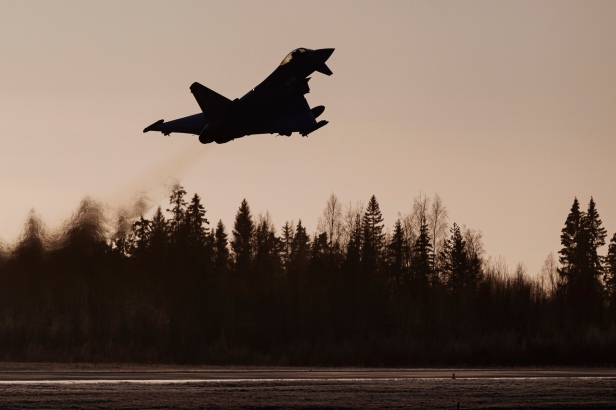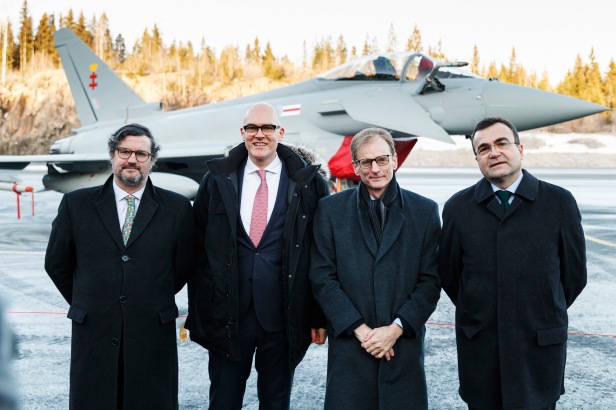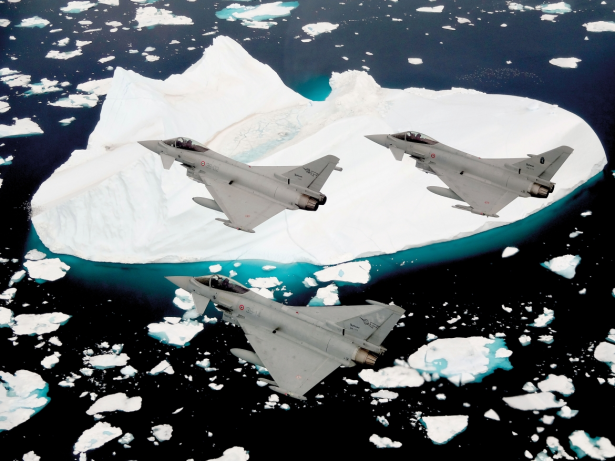HX Challenge kicked off for real this week, with the Eurofighter Typhoon being the first contender (the sales team uses the Eurofighter designation, but I sincerely hope any Finnish buy would include us switching the British name. One possibility I might accept is translating it to Pyörremyrsky).

Did we learn anything groundbreaking yesterday? Not really, but the media day did provide a comprehensive insight into what the consortium in general and BAE Systems in particular believe is their strong cards in a competition that is steadily moving towards the contract announcement next year.
The key word is “independence”. You buy it, you own it, and you decide exactly how you want to use it. These are notions repeated throughout the press material and briefings, and it is clear that they are aimed at differentiating the European project against the US competitors. The Eurofighter is described as providing an “unique opportunity” when it comes to taking control of the country’s security. The “no closed black boxes”-policy provides the ability to independently operate, maintain, and control the aircraft, also when it comes to questions such as mission data and upgrade paths. Full control of mission data is described (in the Finnish press release) as “indispensable” for operating a modern combat aircraft, and something that provide an information advantage that will only become more important as time goes*.
However, this should not be interpreted as BAE Systems pushing the “buy second best but get full control”-line. The aircraft is described as being the “most advanced multi-role aircraft on the market”, with the potential Finnish aircraft being given as ‘Tranche 4’-standard, i.e. one notch above anything produced up until this point. This is roughly the same configuration as the German order under Project Quadriga, importantly sporting the E-Scan Mk. 1 AESA radar, an upgrade compared to the Kuwaiti-standard featuring the export Mk. 1A. Another interesting detail when it comes to sensors is that of the two Eurofighters taking part in HX Challenge, a single-seat FGR.4 and a twin-seat T.3, one carried the current standard Litening 3 pod, while the other had the brand new Litening 5 which is currently on offer to Germany and expected to be acquired by RAF in the near future. The Litening 5 is also offered in an updated version with a synthetic aperture radar (SAR) integrated into the body of the otherwise electro-optical targeting and reconnaissance-pod. As a side-note, the Finnish Hornets received the most advanced version of the Litening II, the Litening AT, as part of their MLU2-upgrade.

When it comes to weapons, the Eurofighters in Tampere-Pirkkala came equipped with ASRAAM short-range air-to-air missiles. Interestingly enough, the short-range air-to-air capability is not amongst the weapon systems described as ‘best-in-class’ in the press release. Instead, the weapon suite is described as offering “the widest range of weapons in the HX competition”, with beyond visual range air-to-air, deep strike, and high precision air-to-surface capabilities being best-in-class. It’s easy to see the close cooperation with MBDA playing a role here, as the weapons alluded to are the company’s Meteor, Storm Shadow, and Brimstone/SPEAR 3 respectively. The claim certainly seems tailored to meet the Finnish focus on the air-to-air role as well as deep strike, and while it is marketing, it is difficult to find weapons currently on the market that based on open sources can be stated to be objectively superior to the Meteor and the Storm Shadow, with the Brimstone and SPEAR 3 lacking direct competitors in most western arsenals.
But the HX Challenge isn’t just about flying around and punching holes in the air, a key part of the testing is the performance on the ground. This include not only studying how the aircraft function when the temperature is hovering around the freezing point, e.g. whether moisture getting into small crevices and freezing there will break stuff, but also what happens when the maintenance takes place outdoors or when the runway isn’t nice and dry (Finavia is cooperating with the evaluation by not maintaining the runways to their usual standard to simulate winter operations from dispersed bases). In fact, the ground testing will likely be more revealing than the air sorties, which in essence should only confirm data received in the offer and already verified in laboratory conditions.

It is no surprise then that BAE Systems has also answered to this requirement, emphasising the robustness of the aircraft and the ease of maintaining it in similar conditions, such as during the Italian Air Force rotation to the Icelandic Air Policing mission and the RAF detachment operating in the Falklands. In Iceland the aircraft encountered exactly the kind of low temperature and wet conditions that the Finnish Air Force is interested in, and still were able to launch for all available missions. The squadron commander attributed this to the professionalism of the maintenance crews, as well as the fact that the aircraft is “very simple to maintain”.
The impact Tempest and FCAS will have on the development path still hangs as a cloud over the Eurofighter, regardless of promises that it will continue to be upgraded into the 2060’s. Still, the large number of operators gives the promise more credibility compared to corresponding promises by the other two eurocanards. With TyTAN going smoothly, the consortium is also confident enough that they have declared the cost of acquiring the aircraft to be “fixed and affordable”, going as far as stating the aircraft to be “the world’s most cost-efficient multi-role fighter”. The marketing plan seems simple enough – the Eurofighter is already here and working, it would increase Finnish cooperation with most of the major European security players, it allows fully independent planning of operations, upgrade paths, and maintenance (looking at you, F-35), and comes with a serious package of industrial cooperation benefits that would give Finnish aerospace and defence companies ample opportunities of cooperation with their European peers. How much of these talking points is backed up by real world prestanda is an open question, and one to be decided over the next twelve months.
The game just got serious.
*Interestingly, the information advantage-point is only found in the English version of the press release, and not in the Finnish one


Very interesting points in favor of Typhoon. Can the consortium keep their upgrades consistent so that most of the nations are paying for them — that is the question. Of course, this would increase the chance that one of the upgrades is aligned very well with our needs. In comparison Rafale’s upgrades probably solely depend on AdA’s wishes and if their needs are different from ours (no idea, how) we’d be out of luck. Though, with just France, the decision making for the upgrades would be streamlined and not in limbo for indeterminated time like with Captor-E.
With Gripen E we would end up paying hefty part of upgrade developments, though some of that would probably be done in Finland. Still, the FAF is looking ready system with a future.
I suppose, that LM with F-35 can give us enough independence as it have passed the prerequisite gates as all the planes, but is that affordable for us to set up a independent servicing facilities.
“as it have passed the prerequisite gates”
Those gates have not been checked yet because Finland wants to keep all competitors in the game until the bitter end. Like Puranen hints indirectly: “Niinkin voi käydä, että kaikki tarjoajat eivät kykene tarjoamaan täysimääräistä suorituskykyä annettujen ehtojen puitteissa. ”
“Annetut ehdot” = gates
“as it have passed the prerequisite gates”
Those gates have not been checked yet because Finland wants to keep all competitors in the game until the bitter end. Like Puranen hints indirectly: “Niinkin voi käydä, että kaikki tarjoajat eivät kykene tarjoamaan täysimääräistä suorituskykyä annettujen ehtojen puitteissa. ”
“Annetut ehdot” = gates
Weren’t the gates supposed to be passed before the candidate could progress in the selection process? Perhaps I took the graph about the gates too literally, then.
I can understand that one could pass all the gates, but still not be affordable enough to be suitable selection; as I guessed, that LM can provide the independence, but with such a price that is not realistic as we could afford too few planes, however good they individually turned out to be. The best plane might not be the most suitable plane.
Bids that arrive in few weeks time are first ones with rule set of 10 billion and non-fixed number of fighters. From that alone, you can realise that gates are not checked and Puranen confirms it in his program status update as I copy-pasted.
Another interesting hint is that all bids could contain a different number of fighters. As fighters operate in formations of 4. Bids could be 56, 60, 64 and 68 fighters. Highest number asked in RFI phase was 72, which I consider unlikely.
One funny thing with the Eurofighter is the placement of the canards, when flying CAS and using your eyes they are blocking the view, as a comment to the Litening pods, this is from German Air Force Lieutenant Colonel Lorenz “Enzo” Schaffelhofer in the Fighter Pilot Podcast episod 058 – Eurofighter Typhoon.
How do the Eurofighter cope with the Finnish road bases, at an emergency in Norway it used its emergency hook and blocked the runway?
Funny to mention complete independence and yet rely on non-European providers, like the Israeli Litening pods.
As for the large number of operators giving more credibility to the promise of upgrades lasting until the 2060, you need to take a deeper look at the operators in question. The only country to only use Typhoon is Austria, and they want to get rid of them. The UK, Italy, and Germany used the Typhoon as an air-to-air complement to their air-to-ground Tornado. UK and Italy have switched the Tornado to the F-35, and Germany is seriously thinking of switching the Tornado to the Super-Hornet. Spain used the Typhoon as a complement to their Mirage F1, which were replaced with the Hornet. Export customers besides Austria all use the Typhoon in addition to American jets (Saudi F-15, Omani F-16, Kuwaiti F/A-18) or French and American jets (Qatari Mirage 2000, Rafale, and F-15). So you don’t have any serious Typhoon user for which this is a “single basket” situation.
Seriously, reading this blog make you understand how incredibly complicated matter Hx-program is.
Not simply that plane x is most capable…
Hear, hear!
I believe that the FAF have done superb job developing the HX selection process and I would not be surprised to see future fighter acquisition programs elsewhere use similar process. The candidates have done tremendous work for the program and it is a shame, that only one can reap the benefits for their hard work.
This design-to-cost method will not be copied as most fighter selections in the world are more or less political or some small group of generals make a favorite pick. Generals and politicians do not like to give up power, it’s not in their nature. This is why some Finnish journos are skeptical that government would just accept the end-result, no matter what it is.
In some years back, Puranen and pals threatened publicly, that if winner is not accepted, then whole process will collapse and begin from the start(with new faces), and that only winner is revealed, no information who was 2nd etc… Now the tone is very different, political leadership can access all data needed and government will have the final word.
” as most fighter selections in the world are more or less political ”
Who says this is not? Is there any other reason why russians are not in game?
Political dimension is always important b/c technical things do not decide who will deliver weapons before and during a war and who will not do it. Less political is better than more, but “not at all political” can be colossal mistake.
I am not sure if political-thing was already solved when sending call for bids b/c every bidder is western.
“I am not sure if political-thing was already solved when sending call for bids b/c every bidder is western.”
Obviously it was. You don’t have to be a rocket scientist to figure that out. No sane decision maker would ever consider buying a primary defense capability from the only potential enemy. It is ludicrous Russia has been even mentioned in this context (as a potential HX candidate).
Finnish military expects to fight alone without much outside support and HX is build around this idea. Unlikely Sweden, Finland does not have secret security arrangement with the USA and buying USA jets again will not result any new security deal.